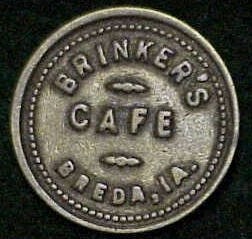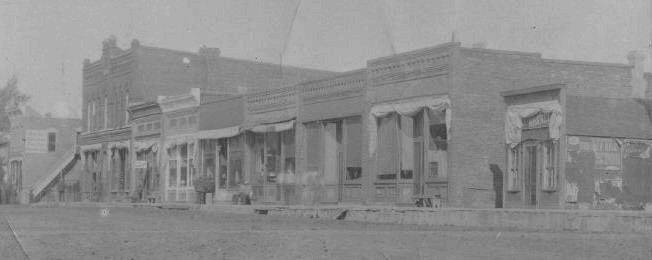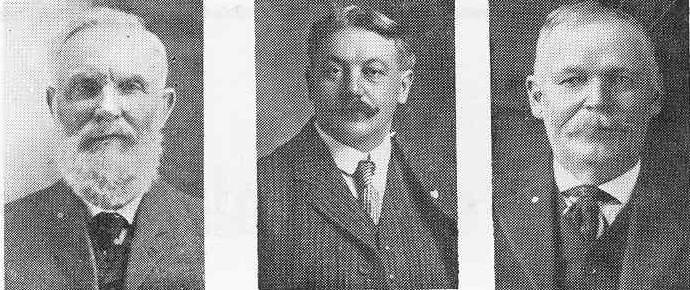
|
Carroll County IAGenWeb |
|
Breda The Iowa Railroad Land Company laid out the village of Breda in 1877, mostly in Wheatland Township. The area is 177 acres. William Arts, now of Carroll, built a warehouse and office, and put in a small stock of groceries, which were sold by Arts & Manemann. Clemens Knobbe built a house for a store, but it was used as a saloon. Fitch & "Wade bought the business of Arts & Manemann. Demons Bruning opened the first general store. Breda has grown steadily, though slowly, and had, in 1885, 278 inhabitants. There are now three general stores, kept by Richard Ricke, Clemens Bruning and Kempker & Bruning; two hardware stores, kept by Ricke & Soat and H. J. Gnam; one drug store, kept by Jones & Albertson, and a Catholic church, built in 1878.
Plastic tokens....in days past these were made of medal.
Breda Saloons Breda has always been known as a "wet" town, and though the young people of Breda may think this is new, it is not. We come by it honestly and from way back. In the early days of this century, we had anywhere from seven to thirteen saloons at one time. In comparison, our Fourth of July celebration is rather pale to those of earlier days. Today, the selling of four hundred cases of beer is usually maximum, where before prohibition they might sell two to four train car loads. Why the big difference? In the early days of this century, liquor was a local option. Sac County was dry so the only watering hole was Breda. Saloons were similar to those you may have seen on "Gunsmoke;" no self-respecting lady ever went in. However, there was one great difference. All the saloons were to be closed at 9:00 P.M. The prices, of course, were a "drinker's delight." A four gallon keg of beer sold for 60 cents, and a gallon of whisky sold for around $2.00. On January 4, 1912, the residents of Breda were hit with startling news. The headlines read: "One saloon in Breda...That's it". "Friday evening the town council met for the purpose of determining how Breda would conform to the recent Supreme Court decision on the 'Moon Law'. According to the decision, towns of less than 2000 population are allowed to run but one saloon. Breda has three, operated by Frank Brinker, Lammers and Heisterkamp, and J. Berkemeier. These men have all been conducting their business in such satisfactory manner that the council regretted to be forced to ask any of them to go out of business and hesitated in deciding which two would be the unfortunate ones. The council was saved this trouble by getting the firms together and deciding among themselves who should remain in business. On Friday evening Mr. Brinker was granted the licenses and hereafter he will own the only saloon in town. We understand that Mr. Brinker squared matters with the other firms in such a way that everyone was satisfied. He took over the entire stock of liquors that the other firms had on hand and has given ample payment to those who would have otherwise been out of a job." Frank Brinker went from here and became, perhaps, the best known saloon keeper of his day. Owning half the town, Mr. Brinker paid up to as much as $3,500 in liquor taxes a year. This monopoly was short-lived. On January 1, 1916, Iowa went dry. This was three years before national prohibition; three years of bootlegging to perfect their talents before the Federal government stepped in. The first liquor runs were to Minnesota to obtain beer and whiskey. Local stills blossomed.
Prohibition lasted
until 1933. During
that time
bootlegging and
moonshine became a
way of life for
many. Vast amount of
money were acquired
by those who pursued
this form of
activity. From the Breda Centennial Book, 1877-1977, Older Days Renewed, pages 297, 299. Transcription by Anita Henning Lemon Grove, CA The following information is from pages 65 of the Breda Centennial Book: “Older Days Renewed, Breda: 1877-1977" (Transcription by Anita Henning <ahenning@pacbell.net> in May 2001)
THE PIONEERS As a prerequisite to becoming a citizen the immigrant took an oath to the effect “that it was bona fide his intention to become a citizen of the United States and to renounce forever all allegiance to any foreign Prince, Potentate, State or Sovereignty (sic) whatsoever” at least two years before the application. This affidavit was also necessary before an immigrant could buy land from the government.
After an applicant
had resided in the
United States for
five years, without
being out of the
territory and within
the State for one
year and “has
behaved as a man of
good moral
character, attached
to the principles of
the Constitution” a
final court hearing
reviewed the
petition. If
approved by the
Court the alien took
a final oath again
renouncing all
foreign titles and
allegiance, and that
he will support the
Constitution. The
court clerk then
gives the applicant
a certificate of
naturalization and
the alien becomes a
citizen.
Please feel free to
contact Susanne or
Anita is you have
questions about any
of these folks.
Also, be sure to do
your own research
using the best
primary and
secondary records
available, before
you assume any facts
to be true. That is
the best and fair
way to approach
genealogical/family
history information.
Old stories are now
referred to as
"family tradition."
They are a great
"starting point,"
but should never be
treated as "fact!" I
can share many
"horror stories" of
"family tradition"
information being
very inaccurate!!
Thanks for
remembering! Enjoy
your research! Bill
The following
information is from
pages 9, 10, and 11
of the Breda
Centennial Book:
Ostrriesische
Nachrischten (News
Paper) Breda Iowa "Older Days Renewed, Breda: 1877-1977" Breda: Origin and Settlement Breda is a town in Iowa located in the heart of the Corn Belt. It is situated in Wheatland and Kniest Townships in the Northwestern part of Carroll County, being thirteen miles from Carroll, the county seat. Breda is on the Sioux City Branch of the Chicago and Northwestern Railroad which was built in 1877. The town of Breda was technically founded when this railroad was built. This typical American rural town has a population of 553 people. Friendliness, honesty, and loyalty are natural customary habits which may be expected from every citizen of the community. It was in 1869 that the first settlers came from Galena, Illinois and Hazelgreen and Dickeyville, Wisconsin to establish new homes on the prairies of Northwestern Iowa. These early settlers were for the most part sturdy Germans and thrift Hollanders. Among the early pioneers were the families of Richard and Henry Ricke, Martin Ludwig, John Le Duc, Mathew Snyder, William Lammerding, Henry Olerich, and Ben and Clem Knobbe. These men bought land from the Railroad Company for $4 an acre.* On the barren prairie lands not a piece of wood as thick as a finger was to be found and not a tree was to be seen. Before many years had elapsed however, these lands, which a short time ago were the hunting grounds for Indians and roaming lands for buffaloes, were dotted with cabins and neatly planted groves of timber and the fruitless prairies were changed into fertile fields. It took men of courage and perseverance to accomplish what these pioneers did. The breaking up of these lands was no easy task for a man could only clear between 10 and 15 acres a season with continued hard labor. Since there were no roads or as yet no church in Breda, people traveled on horseback, in wagons or walked through swamp grass to attend services at Mt. Carmel Church. The children would walk to Mt. Carmel twice a week through the tall prairie grass and mud for religious instructions, and often they were obliged to take their shoes and stockings off and wade through water and swamps. Before the grain elevator and the railroad came to Breda the farmers would load their livestock, potatoes, vegetables and grain on a wagon pulled by oxen or horses and take them to Carroll. They started very early in the morning and came home late in the evening. Since there were no roads on which they could travel, these early pioneers had to make their own trail through the swamps and tall grass. The farmers were later aided in selling their products by railway when the railroad came through Breda in 1877. Eventually the greatest step in aiding the pioneers by way of transportation was the automobile and the truck. The automobile aided in taking people to town, to church and for business purposes. The truck was used for hauling the needs of the farmer or businessmen in town and for the selling of goods to another city or farm. The first roads that the farmers made were very crude. They took a walking plow and made furrows for the ditches. Then they cleared the tall grass from between the two furrows. When it came to grading the road they used a crude grader consisting of large heavy planks which they dragged on the ground. Later the county furnished heavy steel graders with a long blade underneath to cut down the roots in the road. Although Carroll County is not rich in gravel deposits they later obtained it from neighboring counties to surface the roads. A great inconvenience for the early pioneers was the snow storms in the winter season. Sometimes the settlers would not see one another for weeks and in some severe cases for a month or more. In 1869, before Breda was an incorporated town, the inhabitants were governed as a part of the township. Trustees of the township attended to all business and local affairs. The Secretary of the Board of Trustees was in charge of legal documents and transactions. Elections were held at appointed posts such as school houses and community centers. In 1871, the Chicago fire caused many who had lost their homes to come to the plaints [sic] of Iowa. Many settled in Wheatland Township. In the summer if [sic] 1877, the Sioux City Branch of the Chicago and Northwestern Railroad was built through the community. The question arose as to the location of the depot. This question brought up a discussion and several pioneers were in favor of having it built one mile from its present site. The company finally bought 177 acres from Clem Knobbe, Benedict Schettler, Henry Rieter, and William Arts and located the depot at its present site. Other buildings soon surrounded the little station, and the town of Breda was formed. The question is often asked why the town was named Breda. Some of the first suggestions for names were St. Clemens and Artsville. Because Superintendent Hall and the building force of the Northwestern Railroad were then stopping at the hotel of John Le Duc and during November of that same year the town was founded, he gave Mrs. Le Duc the honor of naming the town. At first, the names of New Holland and Roermond were suggested, but as there were already other towns in the state whose names were similar to these, they were rejected. Then Mrs. Le Duc suggested the name of Breda in honor of a city in Holland. As there were no other towns of that name in Iowa, the town was named Breda. Mrs. John Le Duc had the honor of naming the town in return for the painstaking services she rendered Superintendent Hall and the construction crew of the Northwestern Railroad Co. On October 30, 1877, an election for the incorporation of Breda was held. It carried by a vote of 36 for and 5 against the measure. The names of the 44 men voting in this election were as follows: S. N. Mc Cormick, J. H. Knobbe, J. Vaneventer, A. J. Powell, Joseph Dyke, Ubba Alberson, H. Scott, Henry Brunning, Henry Olerich Jr., U. C. Jones, Henry Olerich Sr., H. W. Lammerding, W. Lammerding, J. H. Bohenkamp, Frank Salmen, Joseph Kempker, J. B. Eberly, R. Ricke, J. L. Perry, A. T. Olerich, John Olerich, Frank Lake, Anton Stork, Joseph Olerich, John Franzen, Theodore Loch, John Le Duc, Joseph Schelle, Fred Geets, G. Hannsen, J. Frank Derner, N. Cortenbach, C. Knobbe, Henry Paper, Wm. Leets, B. Bruning Sr., J. H. Brunning, V. R. Jackson, A. L. Gnam, Herman Gnam, and C. Bruning, Sr. Thus through the efforts of our pioneers and the continued progress throughout the ensuing years, Breda has developed into one of the cleanest rural cities to be found anywhere. It is most progressive and therefore offers the community many advantages rarely found in other cities of its size.
BREDA---OUR CITY
BEAUTIFUL! Mayors throughout the years
1883 - 1902
Frank SALMEN**
The citizens of
Breda are deeply
indebted to these
men for their
leadership and for
their time spent in
developing our city
into one in which we
can be truly proud
of in this our
Centennial year. *In reviewing the land records in Carroll County, Mathew Snyder, one of my ancestors, paid $3.75 an acre for his land in Kniest Township, which he contracted to buy in 1869.
Mayor Salmen Mayor Laugel Mayor Olerich
Blizzard of March
1870 The following is transcribed from “A History of Carroll County, Iowa: a record of settlement, organization, progress and achievement” by Paul Maclean, published by S. J. Clark, Chicago, in 1912; pages 175-180 (from L D.S. microfilm #0934932). I have kept the original spelling and punctuation. At the end of the chapter is some identifying information about some of the persons in this account (Transcription by Anita Henning <ahenning@pacbell.net> in May 2001) CHAPTER XV RADICAL MODIFICATION OF CLIMATE COMES WITH SETTLEMENT--WINTER’S BLIZZARDS AND SUMMER’S TORNADOES --SAM TODD’S STORY OF AN EARLY DAY TRAGEDY--PARTY FROM HILLSDALE VISITS CARROLL AND IS CAUGHT BY MARCH STORM--FOUR OF THE PARTY REACH HOME IN SAFETY--FOUR DRIFT WITH THE STORM AND ARE LOST--BLIZZARD CONTINUES THREE DAYS AND THREE NIGHTS--CHARACTER OF THE STORM--AFTER IT SUBSIDES RESCUE PARTY IS ORGANIZED TO LOOK FOR THE MISSING MEN--TWO BODIES FOUND FROZEN STIFF UNDER BOX OF SLED--BROTHERS PERISH ON THE CARROLLTON-HILLSDALE TRAIL--HORSES FOUND ALIVE BUT CRAZED WITH SUFFERING AND EXPOSURE--CLOSING OF THE TRAGEDY There can be no doubt that many and radical modifications of climate have come about within the years which have passed from the present back to the time when the first white man came and made his settlement in the bottoms of the Middle Coon. The extremes of both summer and winter were then manifestly more severe, and while a certain large allowance must be made for the exaggeration of tradition there is every warrant for the belief that tales of snow six feet deep on the level; blizzards that prevailed for weeks; periods of heat and drought, tornado, hail and insect plague in presence of which farming as a settled and profitable industry was thought to be futile, are not all fiction. Fifty years ago one might stand on the high point of the divide or any of the eminences of the county and see for miles, or as far as vision can reach at sea, over a rolling uniformity of space of the same color and character, without an object in all of that visible zone to serve as a landmark, save perhaps the course of a stream, where the grass was ranker and taller or some rare and peculiar outcropping of the surface. Over these unbroken stretches the winds had fair and free play, carrying with them from the northwest in winter the cold and storms of the Arctic's, and in summer, from the south and west; the “hot winds” at the touch of which vegetation withered, or the tornadoes whose powers and malevolence are not to be described. But fifty years has changed the face of nature. The field of vision from the higher point is now confined to a few miles, and is everywhere interrupted and broken in upon by trees and houses. Forestation alone is said to modify and balance climatic excesses, but when to widespread tree-culture is added the many barricades afforded by the improvement and development of the towns and farms, the original forces of nature are much disturbed in their freedom and where they were once terrible have become comparatively tame. The tragedies of the old times, however, must not be discounted by the security of the present, when the seasons roll around in a procession with little to distinguish the fat prosperity of one from the fat prosperity of the other; when life in Carroll county is subject to no hazard that there is not a doctor close at hand to cure, and when the most likely vicissitude is the possibility of death from old age. On the 13th day of March, 1870, all of the men folks of Hillsdale--and this includes all inside of what is now known at (sic) Roselle township--got up early in the morning, dispatched their chores, and hitched up their teams for a trip to Carroll. Sam Todd, the only survivor of the expedition now living in Carroll county, is telling this story. “That was a pretty fair sort of a March morning.” says Sam. “There was a little snow on the ground, enough to make a sled run smooth if you kept off the high places which the wind had blown bare. A light snow had fallen the day before, which was Sunday, and before that we had been hauling hay from old man Cole’s place on Brushy. The weather had been mild for some time and it looked as if there was going to be an early spring. It never had more of that appearance than the morning we started out for Carroll--three sleds of us with four teams. In my party there were Joe James and Joe Mathias. Hussey and Coppage came in together, and with the third sled there were four men, Horn, Ashelberger, and two young Germans, who had just come over, by the name of Bruner. They brought in a load of wheat and had two teams hitched to their sled. This was all the men there were in the settlement except father and another old man. We didn’t try to drive in by the trail; just followed the low places where there was snow enough to make the sled run easy. It was warmish and some watery clouds made it look a little like rain. We all had some traps to buy and errands to do in town. I was busy and didn’t notice things much and was a little late getting a pair of shoes fixed at the cobbler’s. But about noon I had finished up everything. It was still warm but the sky had clouded over. A little snow was falling in flakes as big as your hand in mushy, wet dabs. There was some wind and when I ran across Joe Mathias and James a little later on Fifth street it was blowing hard--the snow still coming, not heavy but in the biggest flakes I ever saw. There was sharp lightning and thunder. When I met the boys they said we had better start for home, and I was willing, for I didn’t like the looks of things. “‘By dad, Sam,’ said Joe Mathias, ‘We’re goin’ to have one of them things you read about.’” “I asked him why.” “Look over there,” he said, pointing to the northwest. “I tell you it didn’t look just first class to me, either. Coppage and his partner had started out a few minutes ahead of us. The other team, I found out afterwards, left town about fifteen minutes later. “Well, in those days there wasn’t a house between Carroll and Hillsdale. There were no fences and no other features--just a rolling prairie. South of the river there wasn’t any trail worth speaking of. Every fellow made his own trail in those days. “It was blowing right smart when we started, as I said before, but when we got in the open country across the ’Coon, those big flakes had split up into a million little pieces and were coming at us stinging and slantways. A man could have walked into it head-on the way it was then, but he wouldn’t if he could have helped it. Ever see one of them storms? Every second it was growing blacker and thicker and colder. We had to go quartering and the team was beginning to want to take the storm in the rear instead of the flank and go with the wind. But old Sam he had the strings and he knew he had to hang on to the off line and make the critters go his way or there would be trouble. Well, we went b’guess--and--b’ god for a couple of hours. We didn’t know for sure any more where we were than nothing,’ but we knowed we ought to be somewhere near Hillsdale. Say, the way she was a comin’ was a plenty. The whole works had broke loose. They was shooting’ cinders at us out of cannon, the way she stung and cut. The snow was coming so fast and drifting so deep in the low places that we had to keep on the ridges or get stuck, and just then we didn’t want to be detained. We all wanted to get home pretty bad. We weren’t lost but we suspicioned that we wouldn’t be in just bad luck if we could only get a sight of something that seemed familiar. “The storm kept getting worse all the time and the cold colder. The only way I knew the team was ahead was by the feel of the lines. Old Dobbin’s rump wasn’t in sight, but I was hanging on to that off line like grim death and I knew we were still going quartering with the wind. Well at last we could tell by the way the sled was running that we were climbing a middlin’ steep hill. Then the runners on one side bumped up and the sled came near going over. Joe Mathias jumped out to see what was the matter. We had run over a heap of nigger-heads that some one had piled up on the top of the hill just north of Hillsdale. We were mighty tickled, for then we knew just where we were at. The settlement was south of us. We lived a mile west. Over a little ways was a quarter-section, around which there was about five furrows of breaking which had grown up with weeds. If we could strike them weeds we could follow them right up to my old shack door. We had our luck with us, but near frozen, it was all the three of us could do to make the team half-face the blizzard. Mathias and James got out and led the brutes and we at last got home, plum tuckered out, half frozen and most scared to death. “Well, the storm kept up all night and the next day--and the next night and the next day till four o’clock in the afternoon of the 15th. It had been 35 degrees below zero for thirty-six hours. The wind was so heavy that we had to go out once and brace the cabin with the boom-pole of the hay wagon for fear it would blow to pieces. When the heavy blasts came the shack just canted forward and groaned back and the nails that held it fairly screeched. “The storm came to an end in an hour’s time and the sun came out. But the air was still so full of snow--there was no wind now--that it seemed to be still be snowing. Many of the hollows were filled bank high with snow twenty-feet deep, but the knobs were swept bare. We went over to the settlement as soon as it was safe to go outside, and there we found that Bussey and Coppage had got home after a hard fight. “But Horn and his party had not showed up. The women and children were crying pitifully. We comforted them as much as we could by saying the men might have stayed in town, but they did not believe it and neither did we, though it was at least a hope and some comfort. “The next day we men hitched up and went back to town, shoveling our way through the drifts in places. In town they thought we all must have perished and the newspaper man, J. F. H. Sugg, had already made a party to go out and look for us. A crowd of fifty men soon started back in sleds in search of the missing men and outfit. There was little or nothing to trace them by, but the men scattered on foot and when we got east of Hillsdale a sled track was found about two miles out going with the wind. By care it could be followed. The sled had packed the track and the wind had kept the snow from filling it so that occasionally these marks were found leading south and east. A couple of miles of careful work brought the rescuers to a hill which overlooked and somewhat sheltered a low gully. At the bottom of this they saw the upturned bed of a sled, where a ghastly and shocking spectacle lay in wait. Under this protection we found the bodies of Horn* and Ashelberger*, one sitting upright on a pile of sacks with the head and face sheltered by the hands. This was Horn.* Ashelberger was lying on a blanket. Both were frozen into solid chunks of ice. A mile from the sled we found two of the horses walking round and round in a track which their hoofs had beaten hard and deep into the snow. The beasts were crazy and on the point of perishing from hunger and cold. The other team drifted before the storm to the Cole place on Brushy and had been given shelter but not until after the storm had gone down. They had also beaten a hard path around the fence enclosure. “The bodies of the Bruner* boys were found on the old mail road from Carrollton to Hillsdale, several miles from where their companions were found. They had left the sled together and were driven by the storm toward the road along which ditches had been plowed and there was some grading to mark the way. When found they had separated. The weaker brother had fallen and struggled to his feet and fallen and struggled again. The tracks showed that his brother had helped him. But when he could go no further the other pushed on and his body was found a mile beyond on the way to Carrollton, with sustenance and safety still ten miles away. “The Bruners had evidently remained with the sled until daylight and had perished early on the second day of the storm. If they could have faced the storm for the same distance they traveled toward Carrollton, both would have been saved, for the road would have taken them to Hillsdale. But it was not in the power of human strength to face such a storm.
“The bodies were
taken to the Horn
and Shellenberger
place” resumed Mr.
Todd. “They were
laid on planks
around the red hot
stove and I was left
to act as fireman
and watcher for the
night. I would not
want to go through
the same experience
again. Frequently,
as the bodies thawed
out, they would
move, and a good
many times that
night my old hair
stood straight up.
That was the longest
night I ever put
in.” And Mr. Todd
scratched his now
denuded crown
reflectively. Information below is not from the book *The following are the names of the men who died in this blizzard, including their year of birth and/or age, transcribed from Our Lady of Mt Carmel Cemetery (tombstone inscriptions), Mt Carmel, Kniest Township, compiled by the Carroll County Genealogy Society, published by the Iowa Genealogy Society, on p.5, (from L.D.S. microfiche #6111404). [Note difference in spelling of Aschelberger name.]
Row 7-Bruner,
Wendlen
-14 Mar 1870 Aged 38
years
1. It contains information about the history of the area, including the dangers of the prairie in 1870. Since one of my ancestors had arrived in Carroll County, Kniest township in 1869, I can imagine that he probably also experienced this storm, hopefully from the safety of his "home". 2. In 1874, my great grandfather, Hendrik Tegels married Catherine Eschelbacker Horn, the widow of Anton Lawrence Horn, one of the men who died in this storm. [Hendrik's wife, Elizabeth, had died in 1873 in Kniest Township, and her tombstone inscription is also included in Our Lady of Mt Carmel Cemetery (tombstone inscriptions), compiled by the Carroll County Genealogy Society, on p.6, from L. D .S. microfiche #6111404]. In addition, in 1879, one of Hendrik's sons, John Tegels, married one of Catherine's daughters, Elizabeth Horn.
Anita Henning <ahenning@pacbell.net>
Lemon Grove, CA
|
Page updated by Lynn McCleary December 31, 2017
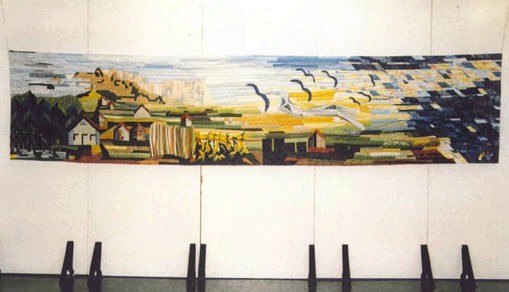
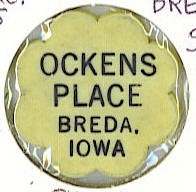 50c
50c
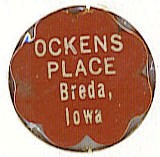 10c
10c
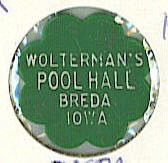 10c
10c
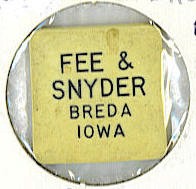 15c
15c